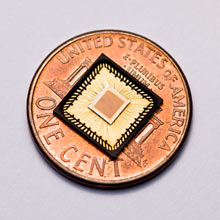Created the first "probabilistic processor"
 The Boston company Lyric Semiconductor has developed a new type of chip that is based on probabilistic calculations instead of standard boolean logic.
The Boston company Lyric Semiconductor has developed a new type of chip that is based on probabilistic calculations instead of standard boolean logic.The design of the GP5 processor is designed so that the logic elements are not bits, but an analog signal, which reflects the Bayesian probability of various events. Instead of the usual transistors in the chip, Bayesian logic gates are used. Such a gate at the input can receive the probability of two events (for example, the probability that this bit is 1, and that bit is 0) and output at the output the probability with which these events intersect.
Lyric Semiconductor has been working on a microprocessor design since 2006, partly funded by the DARPA military agency.
The theoretical basis for the probabilistic processor developed Ben Vigoda (Benjamin Vigoda) from the Massachusetts Institute of Technology (here are the theses of his scientific work in 2003 ), co-founder and CEO of Lyric Semiconductor.
')
According to the developers, such a chip can be a thousand times faster than a conventional processor to cheat on financial modeling systems, recommendations systems in the Amazon store, or control the operation of spam filtering filters. From the point of view of DARPA, the chip can be used in pattern recognition or radio interception systems.
As shown in the demo video, the processor can even be programmed to effectively distinguish computer users by “keyboard patterns”, that is, by typing on the keyboard.
To date, Lyric Semiconductor has manufactured the first commercial sample of the processor, sharpened for one task: a flash memory controller , which performs the function of error checking. Since statistical computations are actively used there, for which Boolean logic is poorly suited, the Lyric chip turned out to be 30 times smaller in size than similar chips on a standard design, and consumes 12 times less energy.
Within three years, the company promises to release a full-fledged version of the universal probabilistic GP5 processor and tools for its programming.
Source: https://habr.com/ru/post/102152/
All Articles